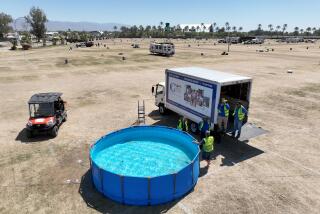Desert Lake That May Be Vital Stop for Birds Is Running Short of Water
No one knows from where they come or exactly when. But come they do, seemingly in growing numbers, for a few weeks each spring and fall to gorge on the fishy feast from these waters to sustain them on their migratory journeys to who knows where.
Common loons have always been sighted at Walker Lake. But it was only several years ago that biologists and wildlife experts discovered that this struggling desert lake may be a crucial pit stop for the birds as they make their way to summer breeding areas in the north and winter havens along coastal waters.
“We’ve known they were here, but we didn’t know the numbers that were here until 1988,” said Larry Neel, a wildlife expert with the Nevada Division of Wildlife.
That spring, officials counted 200 loons at the lake. Six hundred were counted that fall. Even more showed up the next year.
“That was when we realized we had something special,” Neel said.
The loons created excitement within the North American Loon Fund and attracted the attention of two scientists, who are studying the birds at Walker Lake.
Biologists Judith McIntyre, a professor at Utica College of Syracuse University in Utica, N.Y., and Jack Barr, of the University of Guelph in Ontario, Canada, have studied loons for about 30 years.
They hope their latest, monthlong project, financed by a grant from the National Geographic Society, will shed more light on the migratory behavior and characteristics of the elusive loons.
“These birds may be the ones that nest in eastern Washington and western Montana, but we don’t know,” McIntyre said.
“Walker Lake is critically important to loons and other migratory water birds,” she said. “In fact, early reports suggest that Walker Lake may be a major staging ground for loons in the western United States each spring and fall.”
McIntyre, Neel and Ernie Reimers, also with the state wildlife agency, invited an observer along to take this year’s official spring loon count at the lake 150 miles south of Reno.
Armed with binoculars, they patrolled up and down the 12-mile by six-mile lake, scanning the shimmering waters for the bobbing, velvety-black heads of the migrating visitors.
In some areas, the count was scarce: Three here, two over there.
Anticipation grew as the boat neared the middle of the lake.
“Here they are,” Neel said quietly.
With the engine turned off, the loons could be heard hooting to each other in their own peculiar chatter, as if to keep tabs on one another.
“They’re quite talkative,” McIntyre said.
Sleek and graceful on water, the birds are adept divers as they search for fish or evade encroachers, a skill that makes them difficult to capture and tag for research.
Their bodies are ill-equipped for getting around on land, where they can barely walk and are unable to take flight.
One wayward loon, apparently disoriented during a recent storm, was found along Interstate 80 near Fernley, miles away from the nearest lake. The loon’s misfortune provided experts with a rare opportunity to tag it and release it. Researchers hope the colored leg band will help them track the bird’s whereabouts.
At the end of the day, the official loon count stood at 1,433--a record, Neel said. Also counted: 92 pelicans, 468 grebes and 165 cormorants.
Although wildlife experts tout the lake’s importance to waterfowl and other migrating birds, the future of Walker Lake itself remains uncertain.
Walker Lake is the end of the line for the Walker River that begins high in the Sierra Nevada.
But since the late 1800s, the lake’s surface has dropped more than 140 feet as competition for water intensified with upstream users.
The lake received little or no water during eight years of drought that ended in 1994.
But even when river flows make it to the lake’s boundaries, much water is lost each year from evaporation under the sweltering desert sun.
A sequential third wet winter and severe flooding along the Walker River Basin in January provided some reprieve for the diminishing lake. Overall, the lake has risen about 8 feet over three years, about half of that amount since January alone.
“The fish are alive because of that,” said U.S. Sen. Harry Reid (D-Nev.).
“If we’d had another two years like the preceding 10, the fish would be dead by now.”
Reid and others agree that the lake’s survival hinges on providing a continuing water source.
“It is important that we commit ourselves to developing innovative solutions to share water so that Walker Lake is protected while ensuring a strong and viable agricultural economy upstream,” said Louis Thompson of the Walker Lake Working Group, an organization dedicated to the lake’s preservation.
Reid wants to arrange talks this summer with users along the river system to hammer out a plan.
“I’m interested in preserving the lake. To do so is going to take a real community effort,” Reid said. “I want everyone who lives and works along the system to be involved.”
More to Read
Start your day right
Sign up for Essential California for news, features and recommendations from the L.A. Times and beyond in your inbox six days a week.
You may occasionally receive promotional content from the Los Angeles Times.






